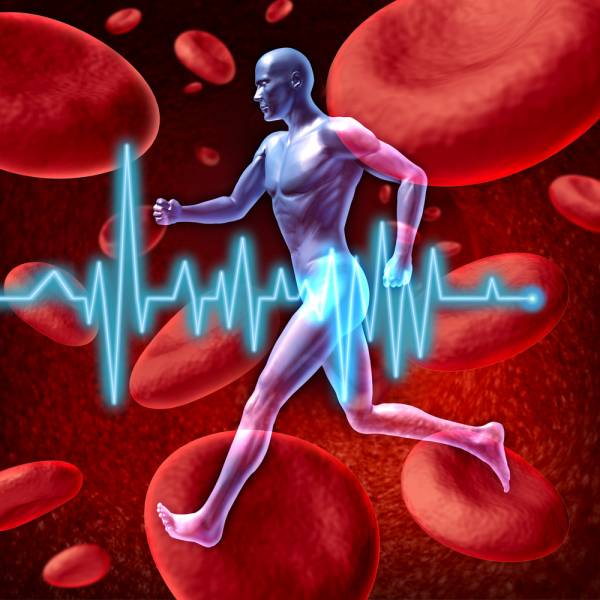In previous articles I discussed the fueling of two of our energy systems – our ATP-PC system as well as glycolysis. In the final installment of this series, we are going to dive into fueling the oxidative system.
In previous articles I discussed the fueling of two of our energy systems – our ATP-PC system as well as glycolysis. In the final installment of this series, we are going to dive into fueling the oxidative system.
This is our primary source of ATP at rest and during longer duration physical activity. Understanding this energy system and how to fuel it can help increase performance in endurance events.
Enough Calories for the Oxidative System
The oxidative system is also known as the Krebs cycle and the citric acid cycle. In this system, carbohydrates and fats are the primary energy sources converted into ATP and this process takes place in the mitochondria of the cell.
Protein is typically not utilized during this energy system except during bouts of exercise greater than ninety minutes and during starvation.1 This means it is critical to be taking in enough calories of carbohydrates and fats to fuel endurance activity.
Low calorie eating and long, slow distance running are common amongst individuals attempting to lose weight. During these bouts of starvation or prolonged exercise we will use our protein to fuel activity.
Our greatest source of protein in the human body is our muscle tissue. If you do not eat enough or work out too much, you run the risk of burning up muscle tissue for energy. This process is known as gluconeogenesis.
Too few calories from under eating or from over exercising can also lead to weight gain. Going too low in calories can decrease our thyroid hormone T3 by as much as 66%.2
This puts our body into an energy conservation mode and can make weight loss extremely difficult. Having adequate fats and carbohydrates in the diet can help avoid these negative situations.
Carbohydrates and Fats
At rest, fats contribute 70% to energy needs and carbohydrates about 30%. As we learned from previous articles, as intensity increases we shift to using more carbohydrates for energy.
As the activity becomes longer in duration (more than three minutes), we shift to using fats as the primary source of energy. The key to this transition is the amount of oxygen present in the blood.

If we have enough oxygen present in the blood, then pyruvate, the end product of glycolysis, is shuttled to the mitochondria and we enter the oxidative energy system.
In this process we get six molecules of NAHD and two molecules of FADH2. These substrates are then brought through the electron transport chain where they are used to convert ADP into ATP.
This process is known as oxidative phosphorylation. This yields us approximately 38 ATP from one molecule of glucose. This is a much higher energy yield than the other two energy systems.
Our stored fat can also be utilized in the oxidative system. Free fatty acids can be broken down into acetyl-CoA and hydrogen. The acetyl-CoA enters the Krebs cycle and the hydrogen atoms are brought through the electron transport chain and ATP is produced. A limiting factor of all this is oxygen uptake.
The Importance of Oxygen
Oxygen uptake is literally a person’s ability to take in and use oxygen. The beginning of all activity is anaerobic, or without oxygen. This is roughly the first three minutes of activity.
After this three minute period we are left with what is known as an oxygen deficit. This is why we continue to breathe heavily once we stop our activity. We need to replenish the oxygen debt.
Remember that enough oxygen being present is what allows us to utilize our long duration energy system. Once the oxygen deficit becomes too high, we will continue to utilize anaerobic mechanisms to fuel activity and blood lactate concentrations will raise and cause fatigue.
This is why it is important to train in all energy systems. Training long, slow distance can help us build an aerobic base and help strengthen this oxidative system by increasing your VO2 max, which is our ability to utilize the oxygen we take in.
Interval training can help us recover by increasing our body’s ability to decrease blood lactate levels as well as making us more proficient at replenishing our oxygen debt.

Ketone Bodies
Another form of usable fats for energy are ketone bodies. Ketone bodies can be found in medium chain triglyceride fats. These are unique because they do not require bile salts for digestion. Instead they are shuttled to the liver, converted to ketones, and immediately used by cells. Research has been done on the use of ketone bodies in endurance training.

Depletion of muscle glycogen, our stored sugar reserves, leads to fatigue. Some research suggests supplementation with medium chain triglycerides can stave off fatigue by sparing our stored glycogen.3
This is most likely due to the easy nature in which medium chain triglycerides are converted to usable energy. Medium chain triglycerides can be supplemented in the diet by using MCT oil or by cooking more with coconut oil.
Half of the fats in coconut oil are medium chain triglycerides. The evidence in the literature is contradictory on the use of medium chain triglycerides, but I have seen it work for a number of clients.
In conclusion, if we are working out for short term, high intensity bouts we need to make sure we ingest enough carbohydrates to fuel activity and to replenish our stored glycogen for recovery. As we exercise longer there is a shift to utilizing fats as a primary source of energy.
Making sure we are getting enough fats in our diet to fuel longer duration activity can help improve performance. Also, adding medium chain triglycerides to the diet may help spare stored glycogen due to the easy conversion to usable energy in the form of ketones.
It is important to keep in mind that not everyone is the same. Some people do well higher carb and others do well higher fat. Planning the best diet for you and your performance will take some tinkering around, but at least now with an understanding of how our energy systems work you can have a good starting point.
References:
1. Thomas Baechle and Roger Earle. Essentials of Strength Training and Conditioning. Human Kinetics (2008).
2. Wadden, TA et al., Effects of very low calorie diet on weight, thyroid hormones, and mood. International Journal of Obesity (1990). Accessed on October 11, 2013.
3. Van Zyl, CG et al., Effects of medium-chain triglyceride ingestion on fuel metabolism and cycling performance. Journal of Applied Physiology (1996). Accessed on October 11, 2013.
Krebs cycle graphic by RegisFrey (Own work) [CC-BY-SA-3.0 or GFDL], via Wikimedia Commons.
Energy pathways chart property of Breaking Muscle.
Other photos courtesy of Shutterstock.






